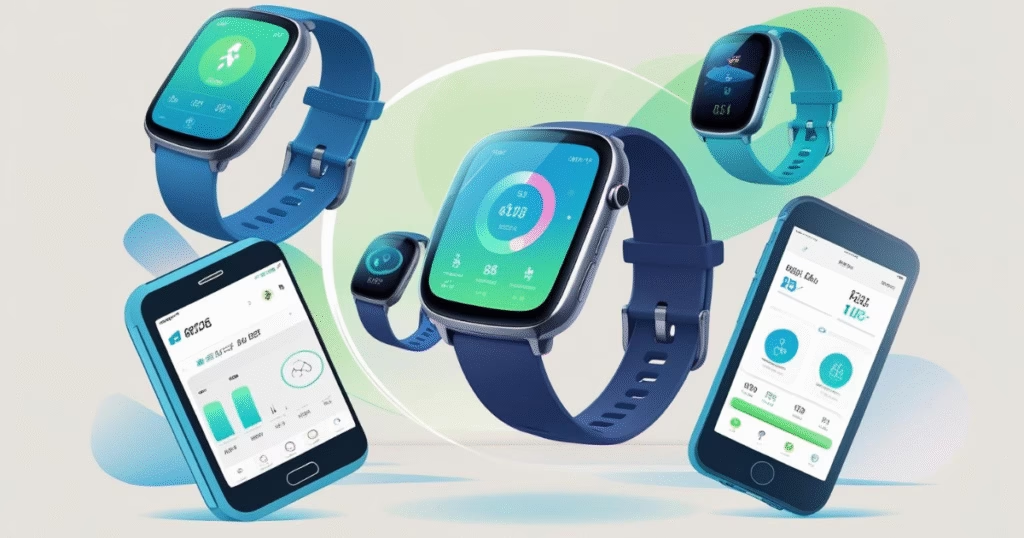Introduction to Fitness Technology
The landscape of fitness has undergone a significant transformation in recent years, largely driven by advancements in fitness tech. This evolution has encouraged many individuals to incorporate innovative tools into their workout routines, thereby enhancing their overall fitness experience. Fitness tech encompasses a wide range of digital fitness solutions, including fitness trackers, mobile applications, and high-tech gym equipment designed to monitor and improve various aspects of physical health.
Wearable fitness technology has emerged as one of the most popular forms of fitness tech, with devices such as smartwatches and heart rate monitors providing users with real-time data on their performance. These devices track metrics like heart rate, steps taken, and calories burned, giving users valuable insights into their activity levels. In turn, this data aids individuals in setting and achieving specific fitness goals, further enriching their engagement with fitness activities.
Besides wearable devices, virtual training has gained traction in recent years, allowing users to participate in guided workouts from the comfort of their own homes. Online fitness platforms offer a plethora of exercise classes that can be accessed at any time, making fitness technology a convenient solution for those with busy lifestyles. The integration of interactive elements like real-time feedback during these virtual sessions significantly enhances the training experience, motivating users to stay on track with their fitness journeys.
Moreover, advancements in fitness technology include smart gym equipment that can intelligently adjust resistance and monitor users’ performance during each session.

The Role of Data in Fitness Tech
In the realm of fitness technology, data plays a pivotal role in shaping our understanding and execution of health-related activities. Devices such as fitness trackers and smartwatches are at the forefront of this revolution, offering users comprehensive insights into their physical performance and well-being. These devices meticulously monitor a variety of metrics including heart rate, steps taken, calories burned, and sleep patterns. By leveraging sensors and algorithms, fitness tech provides real-time data that empowers individuals to take charge of their health journey.
The accuracy and granularity of data collected by fitness trackers facilitate the generation of personalized fitness plans tailored to individual needs. For instance, monitoring heart rate not only provides insight into one’s immediate physical exertion but also aids in determining optimal exercise intensity for improved cardiovascular health. Additionally, step count and calorie tracking can illuminate daily activity levels, prompting users to adjust their routines to meet fitness goals or maintain weight. The data collected during virtual training sessions further enriches this experience, allowing for real-time feedback and motivation.
Moreover, the significance of sleep patterns cannot be understated in the realm of fitness technology. Quality sleep is essential for recovery and overall health, and understanding personal sleep metrics can lead to healthier lifestyle choices. By analyzing this data, users can identify trends, make informed decisions regarding their sleep habits, and ultimately enhance their physical performance during training sessions.
Prefer watching over reading? I dive deeper into topics like this in my YouTube videos. Join me there for actionable insights
As fitness tech continues to evolve, the integration of data analysis will become even more sophisticated, offering personalized recommendations for workouts, nutrition, and recovery strategies. Embracing these advancements ensures that individuals remain informed and engaged in their health journeys, leading to improved outcomes and a better understanding of personal wellness. In conclusion, the role of data in fitness technology is paramount, as it transforms how users perceive and interact with their fitness levels, driving them toward more effective health solutions.
Understanding Heart Rate Monitors
Heart rate monitors have become an essential component of modern fitness technology, enabling individuals to track their cardiovascular health and optimize workout performance. These devices function primarily through two main technologies: optical sensors and electrocardiograms (ECGs). Optical sensors, commonly found in wearable fitness trackers, utilize light to measure the blood flow beneath the skin. By emitting light and analyzing the amount reflected back, these sensors can accurately determine the heart rate in real-time. On the other hand, electrocardiograms monitor the electrical signals that trigger heartbeats, providing precise data regarding heart activity.
The significance of monitoring heart rate during exercise cannot be overstated. By utilizing fitness tech like heart rate monitors, users gain valuable insights into their performance levels. Maintaining an optimal heart rate zone can enhance workout efficiency, allowing individuals to tailor their training to achieve specific goals, whether it be fat loss, endurance building, or recovery. Moreover, constant monitoring aids in preventing overexertion, ensuring safety during intense physical activities. This is particularly crucial for those engaged in virtual training sessions, where real-time feedback from fitness trackers can guide pacing and exertion levels.
Additionally, heart rate data can assist in establishing a personalized fitness plan. By observing trends over time, users can adjust their routines to adhere to their evolving fitness goals, ensuring continuous improvement. Integrating heart rate monitoring with digital fitness platforms allows for a comprehensive analysis of workout effectiveness, ultimately leading to better results. The fusion of fitness technology and heart rate tracking fosters an environment where individuals are empowered to take charge of their health. With accurate data at their fingertips, they can develop strategies that enhance not only their physical performance but also their overall well-being.
GPS and Location Tracking in Fitness Apps
Global Positioning System (GPS) technology has revolutionized the world of fitness tech, particularly for outdoor activities such as running, cycling, and hiking. Fitness applications leverage GPS to provide users with valuable insights into their activities, enhancing their overall performance and experience. By utilizing satellite technology, these apps accurately determine the user’s location, allowing for precise tracking of metrics such as distance traveled, speed, and route mapping.
When a fitness app is activated, it connects to multiple satellites orbiting the Earth. This connection enables the app to triangulate the user’s position in real-time. The location data gathered can be utilized to map specific routes as users traverse their preferred paths, ensuring that they can track their journeys effectively. With this capability, outdoor athletes can explore new areas with the assurance that they will not lose their way. Additionally, the app records their distance and speed, allowing for performance evaluation against past activities.
Incorporating GPS technology into fitness tracking has also paved the way for features such as route sharing and competition among users. Many applications allow users to share their completed routes with friends or within online communities, fostering motivation and engagement. Moreover, fitness technology often includes analytics that can assess performance trends over time, aiding users in setting and achieving their fitness goals. This combination of location tracking and community interaction adds significant value to the digital fitness landscape.
In conclusion, GPS and location tracking in fitness apps serve as indispensable tools for those engaged in outdoor athletic pursuits. As fitness technology continues to advance, it is likely that enhancements in GPS capabilities will further enrich the user experience, solidifying its role in the ever-evolving world of fitness tech.
The Science of Calorie Tracking
In the realm of fitness technology, calorie tracking has become a pivotal feature that enables individuals to monitor their energy balance effectively. At its core, the process involves estimating the number of calories burned during physical activities as well as the basal metabolic rate (BMR), which represents the energy expended while at rest. Various fitness trackers and digital fitness applications utilize sophisticated algorithms that account for numerous parameters such as age, weight, height, and activity levels to provide users with an estimate of their caloric expenditure.
The use of heart rate monitoring is a common technique among fitness devices to improve the accuracy of calorie tracking. By analyzing heart rate data during exercise, these devices can better assess the intensity of the workout and, in turn, provide a more precise measurement of calories burned. Additionally, some advanced fitness technology incorporates motion sensors and GPS data, particularly in activities like running or cycling, to capture the user’s movement patterns and estimate calorie expenditure more accurately.
Despite advancements in fitness tech, challenges persist regarding the accuracy of caloric tracking. Factors such as individual metabolic differences and variations in muscle mass can lead to discrepancies in the data provided by fitness trackers. Furthermore, the methods of tracking caloric intake also pose challenges, as users may not always provide precise recordings of what they consume. These inaccuracies can skew the overall understanding of energy balance, making it essential for users to approach calorie tracking with a degree of critical analysis. As fitness technology continues to evolve, innovations in artificial intelligence and machine learning hold promise for improving the precision and personalization of calorie tracking, enhancing the user experience in the realm of virtual training.
Incorporating Machine Learning in Fitness Tech
The integration of machine learning into fitness technology has significantly transformed the landscape of digital fitness. By utilizing advanced algorithms, fitness apps and devices are now capable of delivering personalized workout recommendations tailored to individual users. This personalization is achieved through the analysis of vast amounts of data collected from various sources, including fitness trackers, user input, and historical activity patterns.
Machine learning algorithms work by identifying trends and patterns within the user’s data. For instance, when a user logs their workouts, a machine learning model can analyze the data to determine which types of exercises yield the best results based on prior activities and user-defined goals. This provides a framework for adaptive fitness programs that evolve as the user’s abilities change, ensuring continuous improvement and optimal results.
Furthermore, the use of artificial intelligence in virtual training offers an enhanced user experience. Many fitness technology solutions now incorporate virtual trainers that dynamically adjust workout intensity and focus based on real-time feedback. For example, if a user is consistently completing workouts with ease, the virtual trainer can increase the challenge, thereby preventing plateaus and promoting ongoing progress.
The evolution of fitness apps powered by machine learning goes beyond mere tracking and analytics. These applications can now offer insights into the user’s overall well-being, taking into account factors such as sleep patterns, nutrition, and stress levels. This holistic approach to health and fitness reflects an important shift in how fitness technology is utilized, making it not only about exercising but also about fostering a balanced lifestyle.
Moreover, as machine learning continues to advance, the potential for even more personalized and effective fitness solutions will undoubtedly grow. With the increasing adoption of fitness trackers and smart devices, the future of digital fitness powered by machine learning looks promising, paving the way for innovative, user-centered experiences in fitness technology.
Wearable Technology: The Good and the Bad
Wearable technology has increasingly become an integral part of modern fitness regimens. Devices such as fitness trackers and smartwatches allow users to monitor various health metrics, offering real-time feedback that can be invaluable for optimizing workouts. The convenience of tracking activity levels, heart rate, and caloric expenditure through these devices provides individuals with a tangible way to measure their progress. Additionally, fitness tech fosters motivation through goal-setting features and reminders, encouraging users to maintain an active lifestyle. Virtual training solutions often leverage this technology, allowing users to engage in guided workouts while receiving instant analytics regarding their performance.
Despite these advantages, the reliance on fitness technology can lead to several drawbacks. One notable concern is the potential for users to become overly dependent on their devices. This over-reliance may result in a disconnect from their body’s natural signals and abilities, reducing the instinctual aspects of physical activity. Furthermore, privacy and data security issues have gained considerable attention. Many wearable devices collect sensitive health data, leading to worries about how this information is stored and shared, potentially exposing users to breaches of privacy.
Another significant drawback is the possibility of inaccurate readings from fitness trackers. While many devices claim to provide precise metrics, discrepancies have been reported, especially regarding heart rate and calorie burn calculations. Inaccuracies may mislead users and affect their fitness journeys, resulting in missed goals or, worse, injuries due to misguided intensity in workouts. As such, it is crucial to understand the limitations of fitness technology while leveraging its strengths.
Balance is key: using wearable devices as a supplementary tool can enhance the fitness experience without overshadowing the inherent value of listening to one’s body and working with trained professionals when necessary. In conclusion, the effective use of wearable technology in fitness comes with both rewards and pitfalls that deserve careful consideration.
Future Trends in Fitness Technology
The landscape of fitness technology is rapidly evolving, with several emerging trends that promise to reshape how individuals approach their wellness journeys. One of the most significant advancements is the development of biometric tracking systems. These systems go beyond traditional fitness trackers by providing a comprehensive analysis of an individual’s health metrics, such as heart rate variability, blood oxygen levels, and even hydration status. Such detailed monitoring can offer insights into an individual’s response to training and overall health, making it a valuable tool for optimizing performance and recovery in various fitness regimens.
Another promising trend is the integration of virtual reality (VR) into fitness routines. VR provides users with immersive environments that enhance the workout experience, making it feel more engaging and less monotonous. This technology allows for a range of activities, from virtual cycling through scenic landscapes to competitive games that require physical exertion. The effectiveness of VR in fitness comes not only from its ability to entertain but also from its potential to enhance motivation and adherence. As digital fitness continues to advance, VR is likely to become a mainstay for both individual workouts and group classes.
Furthermore, the rollout of 5G technology stands to significantly influence the fitness tech landscape. With higher data transfer speeds and reduced latency, connected fitness devices will become increasingly responsive, enabling real-time data sharing and analysis. This advancement could drive innovations such as live-streamed classes with instant feedback, allowing trainers to monitor participants’ movements and provide support instantly. As the future unfolds, the convergence of biometric tracking, VR, and faster connectivity will define the next generation of fitness technology, offering unprecedented opportunities for personalized and effective workout experiences.
Conclusion: The Bottom Line on Fitness Tech
In recent years, the emergence of fitness technology has significantly transformed the landscape of personal health and fitness routines. From sophisticated fitness trackers that monitor heart rate and calories burned to comprehensive virtual training platforms offering personalized coaching, the integration of these tools into daily workout regimens showcases how digital fitness can enhance overall performance. By leveraging fitness tech, individuals can gain valuable insights into their activities, enabling them to make informed decisions based on data rather than guesswork.
The impact of fitness technology on personal health extends beyond mere tracking; it fosters an environment conducive to motivation and accountability. Various applications encourage users to establish and pursue realistic fitness goals, thus maintaining a disciplined approach to training. Furthermore, virtual training options present an opportunity for guided workouts from the comfort of one’s home, making fitness more accessible to a broader audience. In this digital age, the convenience of fitness tech facilitates a more adaptive and personalized approach, ensuring that fitness plans can evolve based on changing needs and preferences.
However, while embracing these advancements, it is crucial to maintain a balanced perspective on digital fitness. Over-reliance on fitness trackers or virtual training can inadvertently lead to burnout or injury if not approached mindfully. It is essential for individuals to remain aware of their own body signals and maintain a healthy relationship with technology. The value of traditional training methods, outdoor activities, and mindful self-awareness should not be underestimated. In conclusion, fitness technology can undoubtedly elevate one’s fitness journey, but it should be used as a complement to a well-rounded and thoughtful approach to personal health.




[…] The Rise of AI Coaching: A Data-Driven Powerhouse […]
[…] The Algorithmic Blind Spots: Where Fitness Apps Fall Short […]